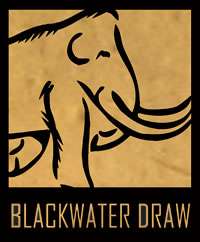Blackwater Draw
|
Blackwater Draw | |
 | |
 | |
| Nearest city | Portales, New Mexico |
|---|---|
| Coordinates | 34°16′40″N 103°19′28″W / 34.277874°N 103.324580°WCoordinates: 34°16′40″N 103°19′28″W / 34.277874°N 103.324580°W |
| Area | 640 acres (260 ha) |
| NRHP Reference # | 66000483 |
| Significant dates | |
| Added to NRHP | October 15, 1966[1] |
| Designated NHLD | January 20, 1961[2] |
Blackwater Draw is an intermittent stream channel about 140 km (87 mi) long, with headwaters in Roosevelt County, New Mexico, about 18 km (11 mi) southwest of Clovis, New Mexico, and flows southeastward across the Llano Estacado toward the city of Lubbock, Texas, where it joins Yellow House Draw to form Yellow House Canyon at the head of the North Fork Double Mountain Fork Brazos River.[3][4] It stretches across eastern Roosevelt County, New Mexico, and Bailey, Lamb, Hale, and Lubbock counties of West Texas and drains an area of 4,040 km2 (1,560 sq mi).[5]
Archaeology
Blackwater Draw contains an important archaeological site that was first recognized in 1929 by Ridgely Whiteman of Clovis, New Mexico. Blackwater Locality No. 1 is the type-site of the Clovis culture.[6] The first large-scale excavation came in 1932. Evidence of "fluted" points, spearheads also known as Clovis points (a New World invention) and other stone and bone weapons, tools, and processing implements were found at the archaeological site. The Clovis points were lanceolate and often longer than Folsom points. These artifacts are in association with the remains of extinct Late Pleistocene megafauna, including mammoth, camel, horse, bison, saber-toothed cat, sloths, and dire wolf[7] that were hunted by the early peoples who visited the site. Generations of some of the earliest New World inhabitants lived at Blackwater Draw which created a layer of human settlement debris from those like Clovis, Folsom, Portales, and Archaic period occupants. The furthest back would be the Clovis culture with radiocarbon dating between 11,600-11,000 years before the present.[8] Blackwater Draw is among the first places these points were found and provides some of the best dated examples.
The archaeological site is known for its well-defined stratigraphic horizons that exhibit numerous cultural sequences. The sequences begin with the earliest New World peoples and continue through the southwestern archaic, and into the historic period. Investigations at Blackwater Draw have recovered protein residue found on Clovis weapons. This leads to the evidence of human occupation in association with Late Pleistocene fauna, including Columbian mammoth, camel, horse, bison, saber-toothed cat and dire wolf. Towards the end of the Pleistocene period, the climate began to change, which brought warmer and drier weather causing the water flow in the region to dramatically decrease. This decrease caused small seasonal lake basins called playas to form. These areas became popular hunting locations for early North Americans.
Since its discovery, the Blackwater Locality No. 1 site has been a focal point for scientific investigations by academic institutions and organizations from across the country. The Carnegie Institute, Smithsonian Institution, Academy of Natural Sciences, National Science Foundation, United States National Museum, National Geographic Society, and more than a dozen major universities either have funded or participated in research at Blackwater Draw. Eastern New Mexico University owns and manages the excavations and visitations at the site.
Blackwater Draw was declared a National Historic Landmark in 1961[2][9] and incorporated into the National Register of Historic Places in 1966.
Blackwater Draw Museum
The Blackwater Draw Museum, was first opened to the public in 1969. The museum opened its doors primarily to display artifacts uncovered at the Blackwater Locality No. 1 Site. The artifacts and displays illustrate life at the site during the Clovis period (over 13,000 years ago) through the recent historic period. This museum is owned and operated by Eastern New Mexico University, and is under the direction of George Crawford of ENMU in Portales. The museum is located at 42987 Highway 70, about seven miles northeast of Portales.[10]
See also
References
- ↑ National Park Service (2008-04-15). "National Register Information System". National Register of Historic Places. National Park Service.
- 1 2 "Blackwater Draw (formerly Anderson Basin)". National Historic Landmark summary listing. National Park Service. Archived from the original on 2007-03-02. Retrieved 2008-05-30.
- ↑ United States Board on Geographical Names. 1964. Decisions on Geographical Names in the United States, Decision list no. 6402, United States Department of the Interior, Washington DC, p. 49.
- ↑ U.S. Geological Survey Geographic Names Information System: Blackwater Draw
- ↑ Seaber, P.R., Kapinos, F.P. and Knapp, G.L. 1987. Hydrological unit maps. United States Department of the Interior, U.S. Geological Survey Water-Supply Paper 2294, p. 46.
- ↑ "Archived copy". Archived from the original on 2007-03-02. Retrieved 2008-05-30.
- ↑ "Archived copy". Archived from the original on 2008-05-23. Retrieved 2009-01-14.
- ↑ Hirst, Kris. "Blackwater Draw Locality 1, New Mexico". About.com. Retrieved 15 April 2012.
- ↑ Note: A National Register of Historic Places Inventory-Nomination document should be available upon request from the National Park Service for this site, but it is not available on-line from the NPS Focus site.
- ↑ http://www.enmu.edu/services/museums/blackwater-draw/
External links
- Theclovissite.wordpress.com: Current research at the Blackwater Draw Clovis type site
- Blackwater Draw Facebook Page
